Ellen and Jim Have a Blog, Too
We are two part-time academics. Ellen teaches in the English department and Jim in the IT program at George Mason University.


Stonehenge, Avebury, and Stanton Drew · 16 September 05
Fanny,
We left Angela’s house in Acton (London) around 2:30 in the afternoon, and were guided to Somerset by a computerized woman’s voice in our Global Positioning Device (Satellite Navigation System), which, perched precariously on the dashboard, and glued to the windshield, would parrot at us, "At the roundabout, take the second exit," or "Turn left," or when we had gone in the wrong direction somewhat naggingly (if still courteous enough not to insult us for our stupidity in still getting it wrong), "Make a legal U-turn."
It had rained, but the rain had stopped and still we were in a traffic jam. How could this be? Deep in Somerset. Then Jim said, "it’s the Stonehenge jam." We turned and looked and sure enough, there it was:
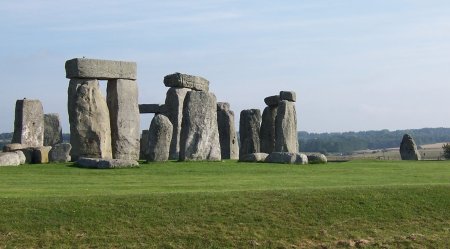
We saw crowds mingling near the stones and thought,"we’ll come very early that day." We got up before dawn.
Alas, to get in before 9 you need a signed letter of permission, which you get by sending a letter to the proper authorities. Still, we were there by 9 and were the first to get in. Laura was able to take a photo just after opening from the west:
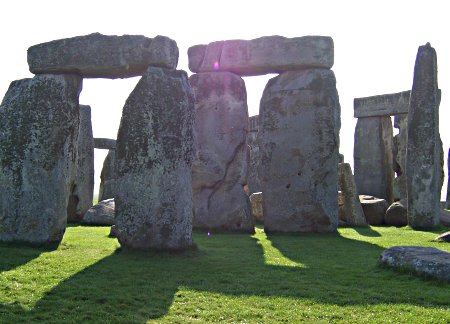
We walked round and Laura caught the only stone standing of the great trilithon. The ones slightly differently colored (brownish actually) are the bluestones:
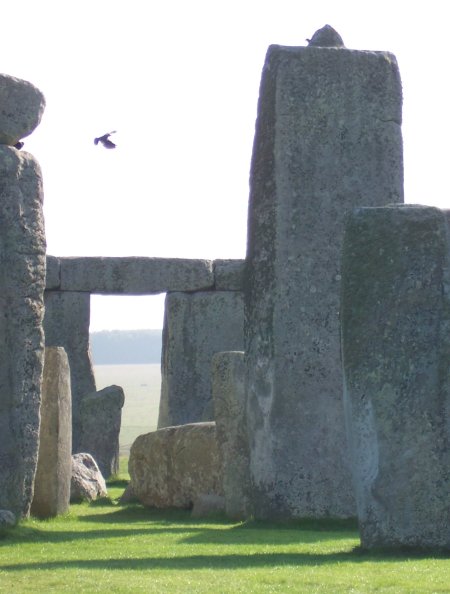
The color of the sunlight had whitened by the time Laura was standing as close as she could to the stones on the west side of the outer rings:
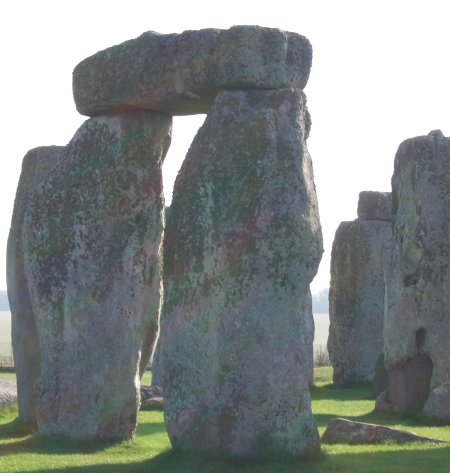
Most of the stones on the southeast section of the outer ring are fallen:
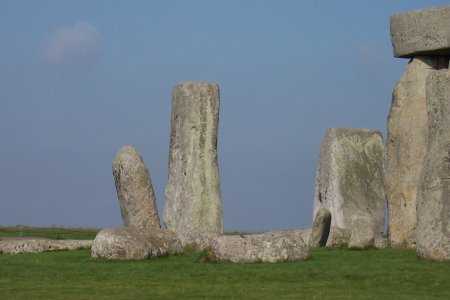
You can look through the fallen group of stones on the southeast, though, and see the inside of the ring:
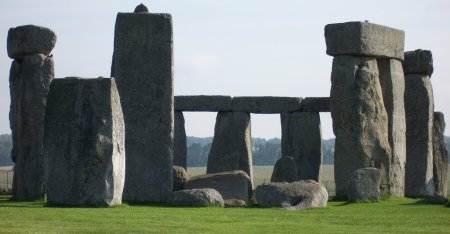
Here we’re seeing one lintel through another. As a extraordinarily good book we bought at the tourist shop, Christopher Chippindale in his Stonehenge Complete, told us when we got back to Croscombe, in the later 19th century particularly, the stones were vulnerable to defacement
from picnics and the like:
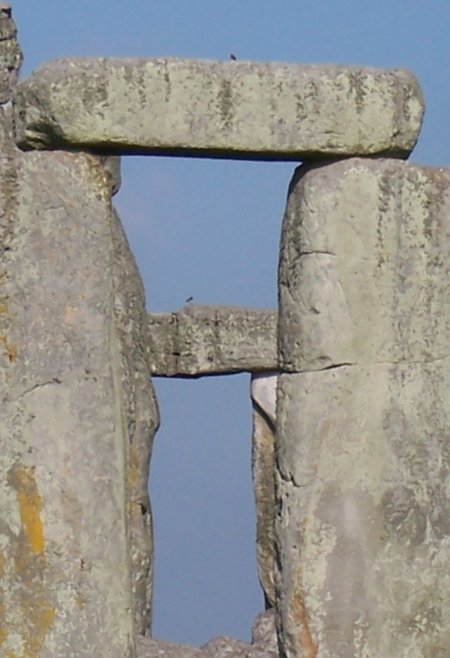
We saw a station stone on each side:
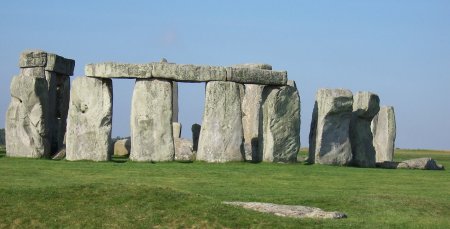
At a distance, the unshaped heel stone which seems to be leaning or tilting to the side:
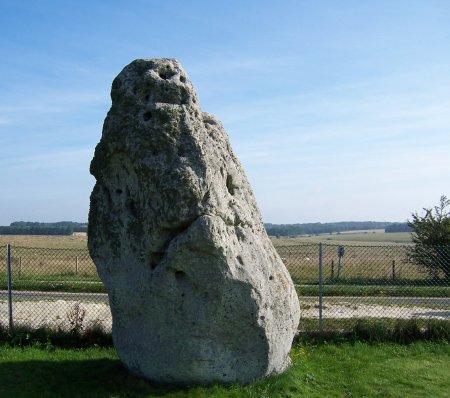
This unshaped stone is very like the stones in the vast stone circles we visited in the afternoon.
Having gone so early, we were able to drive and find Avebury—thanks to our persistent Satellite Navigation System and an old ragged book, half-guide, half archeaology, Jaquetta Hawkes’s A Guide to Prehistoric and Roman Manuments in England and Wales, which we brought all the way from the US with us. We relied on this one in 1976, the last time we came to "Arthur" country and drove into Devonshire, Cornwall, and Wales.
I longed to see Avebury since this summer’s reading pf Jennifer Wallace’s Digging the Dirt, and before that Stuart Piggott’s Ancient Britons and the Antiquarian Imagination where I read f how Heneage Finch, husband of "my" Anne Finch, had climbed some of the stones at Stonehenge with Stuckeley. Jim’s curiosity and interest was aroused by another book we bought at said tourist shop, Stukeley Illustrated, compiled by Neil Mortimer. It had maps of the places themselves we could use to imagine what we were seeing through 18th century eyes.
Fanny, you can’t have read William Stukeley who was the first man systematically to observe, survey and then draw what his accurate careful eye saw at Stonehenge, Avebury, and Stanton Drew. His imaginative powers enabled him to see the relationship between archealogical features and read the landscape as a history book.
You may have read John Aubrey though. Mortimer quoted Aubrey’s words who recognized the importance of what he was seeing at Avebury as well as Stonehenge and remarked that Avebury "did as much excell Stoneheng, as a Cathedral does a Parish church."
We hoped to find more maps at Avebury tourist shop to help imagine what we were seeing when we went from stone to stone, field to field. Also to find the all the individual spots.
We set out around 11. It was a hot sunny day. (Hot sunny England.) This time while there was no Avebury jam, rather we were startled to drive up to the place and find ourselves looking at huge stones on either side of the road that stood in perceptible semi-circles. They appeared to be all over the place spread far and wide. When we found the parking lot and got out of our car, we walked over to the grassy meadows to where the large ring begins:
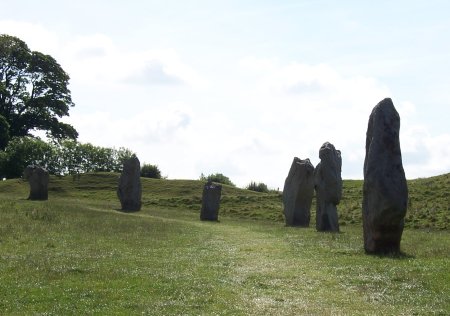
Unlike Stonehenge, the henge at Avebury is large and swings round over several meadows:
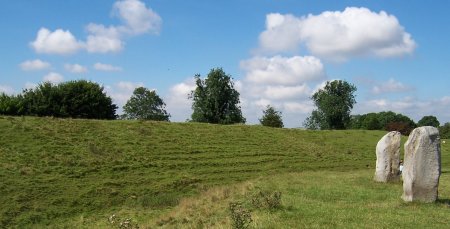
The sheep intermingle with the stones which are themselves in farmed land:
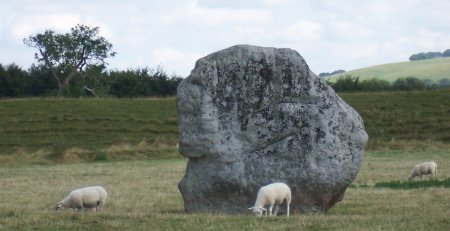
In pieces of the rings lots of stones are missing so Keilor (a 1930s archeaologist) put pillars where he knew stones had been:
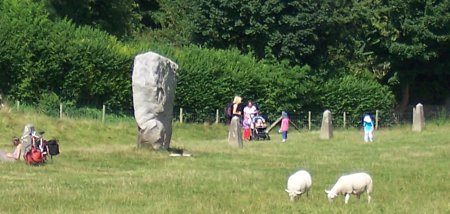
It was exhausting work to try to get a real sense of what this place must have been, and we took off time to go to the Red Bull Inn for lunch. Then we walked up to what had been a long avenue of stones. Where we started from, to echo Jim, "there be cows:"
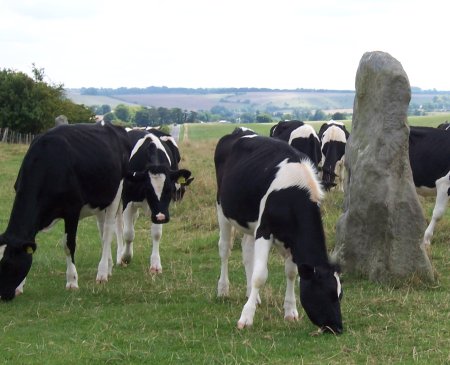
Jim and Laura were much more determined than Izzy and I, and they walked and walked. Izzy and I stayed behind sitting under the shade of a stone. Laura and Jim went down the avenue and took a picture looking towards Kennet:
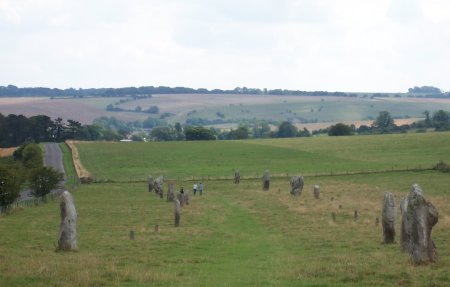
She then photographed what she saw looking back at the village of Avebury:

They returned, and all of us trudged back to the parking lot, and were (thanks to our Device on our dashboard) driving on our way home, when we came upon a marked parking area off the side of the road.
There was a sign to tell us this parking lot was next to where there had been a wooden temple, a central feature of the original "cathedral." We kept driving as said wooden temple was now practically invisible. Had we gotten out we would have seen etchings and objects in the ground to mark where something had been.
A little further was another parking area next to a long path which you could walk (up a hill), a path which connected to another (over another hill) and thus (so the sign said) to a stone burial chamber, West Kennet, Long Barrow. Across the way we could see the man-made Silbury Hill. Laura had longed to see a real burial chamber of this type.
So we parked and walked a long way through the farmer’s land and found it. Laura took several pictures, but they didn’t come out well. It was very dark in that chamber. Not really spooky. It was rather a plain cave. There was some graffitti on the outside stones.
It was then 3 o’clock so we reset our Satellite Navigation Device and she took us to Tesco’s. We bought food and wine, and so home again home again to our 14th century manor hall, jiggedy jig. Then tea and wine and reading in the garden by the graveyard, behind us a church built in the 17th century, & renovated just enough to keep it functioning sturdily and comfortably. Its bells rang the hours. Bong, bong, bong, bong, bong, bong. Six o’clock, time to make supper.
The next day but one we set out in the afternoon for Stanton Drew. This was hard to find. In the morning we had gone to Bath and duly seen the Roman Baths, drunk the waters (well, Isobel did), and peered at clothes in the Costume Museum inside the renovated Assembly Rooms. Izzy and Laura tried on corsets from the period and we decided they were actually useful in holding in the body to fit the contemporary fashions. Isobel’s suited her and I could see her in one of the costumes Susannah York wore in the 1960s film, Tom Jones. It was hot and we could have gone to the beach (Weston-sur-la-Mare), but we set our device for Stanton Drew.
Books, computer devices, and much patience seemed to get us in a maze of high hedges with nothing but farmland about. Just as we were giving up, we saw three stones placed close together in a garden on the side of the road. Except that they were gathered close together, these were in looks very like the heel stone at Stonehenge and just like many Avebury stones. The garden belonged to a pub just as one of our books had said. We stopped, ordered lunch, and ate in the garden behind the pub next to the stones.
Then we walked on past an old Norman-looking church, over a stile, into a farmer’s meadow and saw two small rings of large unshaped stones. Here is one:

Again, I tired. My feet are very bad. Laura took this photo of me reading the little guidesheet under the shadow of one of the stones in the one large ring:
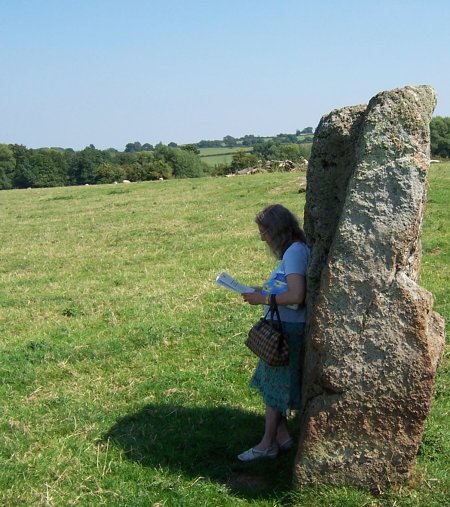
Jim seached for more stones (according to what Stukeley had drawn), but could not find them.
Three days later we returned to Stonehenge, this time at a sensible hour in the morning and on our way to the airport. We had enjoyed ourselves there immensely the first time. Laura had regretted not having bought a small floppy sheep, and I not having bought a frivolous happy larger stuffed one. Although Izzy did pick up a thick beautiful book at the Avebury tourist shop about tarot cards (modern day bogus history intertwines the pre-historical and Roman monuments with New Age ideas and visibilia), the Avebury shop had disappointed us; it was mostly kitsch. We looked at it and wished we had bought two sheep that delighted our hearts just as we left Stonehenge for the first time. We both wanted to have something to remember those eternally munching sheep and the occasional frisking lamb we had so often seen during the week:
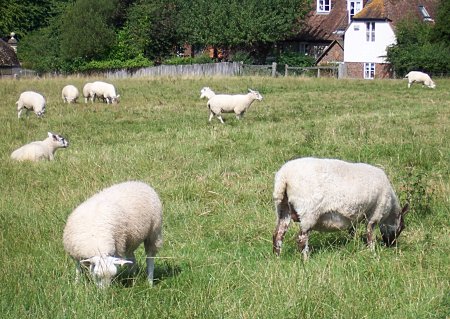
My sheep, a ram, which I named Sweetheart, now sits on the mantelpiece, but I placed it on our old much-worn gold-brown colored sofa (bought at an auction) for the photo:

Chippendale says that Stonehenge is directed towards a midwinter sunset. If we ever get back, we must write first to get permission to see it under the moon.
Not that I romance it. I suspect cruel sacrifices may have gone on in one or all three of these stone temples, but like many historical sites de mémoire, the shell of what was can now be made to harbour and represent quite different meanings.
For me Stonehenge, Avebury, and Stanton Drew today carve out a space which can image present-day human resistance to the destruction of the beauties of this earth; it can also stand for the opposing impulse: human resistance to taking into account what really was. They show us too since they have been left to survive (if I may alive) what human beings potentially can lovingly reverence or thus ideally aspire to be.
Chava
--
Posted by: Ellen
* * *
Comment
- So lovely to see these images and to think of you all wondering and wandering amongst the stones. I’m impressed you made that long trek to the burial mound after such a lot of walking at Avebury. Although Stonehenge has its grandeur you cannot walk amongst the stones any more or touch them as you can at Avebury.
Angela
— angela richardson Sep 17, 7:59am # - Dear Angela,
Thank you for the comment. Yes it was hard walking. We did have a rest inbetween as we drove from the parking lot near the central place for beginning stone-seeing to the parking lot near the burial-chamber.
You can’t beat the temple effect of Stonehenge in the midst of that vast plain, but Avebury is a large landscape as cathedral (as Aubrey had it). And you and others and sheep and cows and cars all mingle
amidst it. In a way it’s lucky for those who go that the place does not attract the huge amounts of tourists and festival-makers Stonehenge does.
Stanton Drew was a final coda too.
We couldn’t have found it withour our faithful Device, which would nonetheless irritate us when every once in a while it was knocked off the dashboard and would suddenly stop working and we couldn’t get it started again for a while.
Chava
— Chava Sep 17, 9:31am # - Lovely photographs. I’ve been to Avebury but I didn’t walk around enough, which now I think was a pity.
— Claire Sep 19, 10:36am # - Dear Claire,
It was reading Piggot’s and Wallace’s books that alerted me to how large and remarkable Avebury is. In Piggot there are these maps, and Wallace’s book includes how she walked through the place, took odd paths, and what she saw.
For Jim it was seeing the Stukeley maps in the book we picked up at Stonehenge. The tourist shop at Stonehenge has some very good books.
Chava
— Chava Sep 19, 11:03am # - Lovely pictures; we took our granddaughters to both sites the summer before last. Did you happen to get to see the white horse at Uffington? I often think of it as a different kind of survival: it’s not that it stands up to time by itself, because people have to maintain it to keep the turf from growing over the chalk. A sort of social survival.
— Russ Sep 19, 2:28pm # - Dear Russ,
How lovely for you too. No we didn’t see the white horse of Uffington, but we did see alongside the road another figure cut out in the chalk. Jim said
that it was a recent carving during some festival. So the custom is kept up. And yes people have to maintain the lines.
It makes me think of children making angels in the snow—or Michelangelo said to have made a statue of Lorenzo de Medici (I think it was) out of snow when he was a boy. It melted. Snow & ice defeat people; chalk is more susceptible.
Chava
— Chava Sep 21, 5:10pm #
commenting closed for this article
